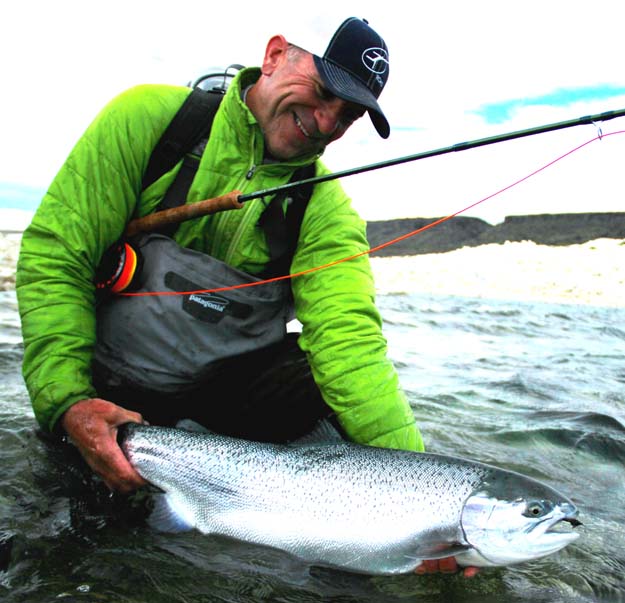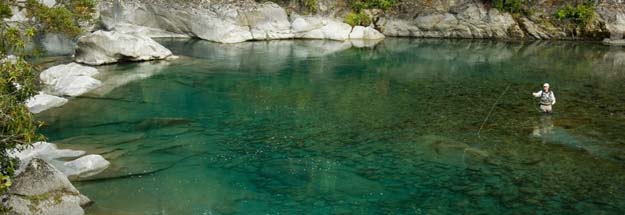
Master angler Tim Rajeff of Vancouver, Washington, lands a monster rainbow in Strobel Lake, Argentina. Image Tim Rajeff.
Modern fiberglass fly rods are the off-ramp into the neighborhood of elevated angling enjoyment
By Skip Clement
We might have started without you, but it was bamboo that began it all. If you’re not familiar with bamboo, you were probably born a little too late. If you know bamboo, you saw it give way to fiberglass, and fiberglass gave way all too soon to graphite.
From a craftsmanship standpoint, bamboo fly rods had long been at their zenith when Glass appeared in the rearview mirror. Today’s bamboo fly rod has advantages over grandpa’s. Still, only via the chemistry of resins, adhesives et al. The craft of building a bamboo rod and the performance characteristics of different types of bamboo seem impossible to improve.
The fiberglass we’re speaking of was born in the 1930s and served as technology in WWII. Think communications – antennae whipping around on the jeeps and tanks in Europe and the Far East and on destroyers and aircraft carriers, then as fly rods, boats, and surfboards. Today, its assemblages are found in thousands of products.
The early glass technologies were S-Glass (Structural), E-Glass (Electrical), and SE-Glass (Owens Corning). They did not all appear on the horizon simultaneously. Instead, their earliest usages were steeped in military and, later, industrial specifications.
Old performance criteria and test data are a bit of a stretch to interpret as they relate to fly rod reactions to casting a fly line. To read more about the history of glass technologies intersecting with fly rods, go to the North 40 Fly Shop or Swift Fly Fishing Company.
Glass fly rods of today are not pure anything fiberglass measured against the original S-Glass and E-Glass. Instead, the glass rods of today have been modified to perform – rolled to a spec either as assembled at the rod builders’ place of business or as a “part” delivered by a glass fabric manufacturer and other vendors.
Fiberglass fabrics are laminated one to another in a specified orientation with flexible adhesives (resins) that bind the fabrics together to create a new, desired flex capability as a fly rod.
Each rod designer has a signature – the performance characteristics based on their interpretation of the “best” assembly of chosen fiberglass fabrics, resins, and other additions making the finished rod react a certain way when loaded with a fly line and in the hands of an angler. That, of course, with a semantics change, could be said of a graphite rod or graphite/boron rod or any build of any fly rod.
So, what are the differences, and why is Glass in its new, modern clothes so unique?
Here’s a clue. Graphite rod ad copy will always claim (usually first mentioned), among other things, how good a rod casts in close. Well, that’s pure late-night political Tweeting because the most challenging casting assignment for graphite fly rods is earning an accurate, quality delivery of a fly up close and personal.
If your rod is graphite and advertised as fast or even medium-fast action, you’re not going to be able to “comfortably” deliver a fly the way you want to at 30- or fewer feet unless you’re Lefty Kreh or very skilled. It’s an awkward cast with the best graphite rod – no matter who you are.
A large percentage of sight fished for the trout, bass, bonefish, redfish, snook, stripers, and other flats and shallow water pescados get hooked at surprisingly short ranges (ask any guide)
You can, of course, retrieve a fly to any distance, but if a trophy brown is sipping at 30-feet away, or that behemoth female tarpon has spun out the daisy chain, retrieving a fly to its feeding window and getting an eat is not going to happen. More likely, it is scaring the Hell out of it because Ephemeroptera and bait fish do not attack predators in the animal kingdom.
What about big ocean animals?
The “fake news” about Glass has been that it’s not a good rod choice versus a tarpon, Chinook, steelies, or significant anything because of being a buggy whip casting tool. But, unfortunately, that postulation is not entirely true.
Many of the best tournament billfish anglers use glass fly rods. A teased marlin has to be cast at about 30-feet or less, and the fish has to discover the 8-inch long lead-headed fly when the teaser it has been following gets yanked away. The rod has to “take it,” and sometimes a graphite rod cannot, especially “AT THE GUNNELS.”
The big issue with a fly rod in the billfish game is lifting and turning; a reel that can slow runs is a significant partner. A 300-pound marlin “requires” a rod that can bend, bend and keep on bending while still exerting pressure. Graphite would not hold up, and so far has proven it cannot.

Carl McNeil left, and Jeanie Ackley directors of The Swift Fly Fishing Company of Wanaka, New Zealand. Image The Swift Fly Fishing Company.
Are glass rods buggy whip fly rods?
Sure, if that’s what was selling, but it isn’t where good angling gets practiced. The real winsomeness of modern glass fly rods is FEEL.
The feel of a fly line loading a fiberglass rod is inherently better than with graphite. Fast action rods are hard to bend and load a fly line. That retards the time it takes for a beginner to learn the quintessential element of a good cast, feeling the fly line load the rod. Glass inherently accelerates learning to cast.
A fiberglass rod is genetically programmed to cast beautifully at short distances and cast comfortably up to about 50-feet (+/-), depending on the rod weight/build. So can a superior caster get 100-feet out of a custom glass rod? Sure, but what’s the point?
What does fiberglass do for me?
It does for you what a graphite rod cannot do for you. If you’re a part-time angler and prone to rusting, fear not, you’ll cast beautifully from the get-go. If a beginner, you’ll get the casting to feel right away; if you’re not so fit anymore, you’ll cast the way you remember you could, and if an expert, you’ll rediscover what pure casting was always about and appreciate the sharpened sense of fish-on.
Anyone who has experienced a fast graphite fly rod, especially in the saltwater weights (seven and up), always finds out search casting for even an hour or so is an Olympic physical demand. The energy required to move a fly line on a fast action graphite rod versus a so-called “fast” action glass rod is night and day. Therefore, using the terms comparatively is misleading.
A fast-action graphite fly rod requires the angler to provide more than half the energy to launch a fly. On the other hand, a fiberglass fly rod offers way more than half the energy to cast a fly.
A glass rod better protects the tippet by acting as a cushion when head shakes and bursts manifest themselves with fish-on.
A glass rod better tolerates bending and abuse. It’s tougher.

In New Zealand, the water is as clear as the air. If you don’t fly fish in New Zealand, you’re a sheep. Image by Stone Fly Lodge – click on the image to visit their website.
The producers
It’s not easy to pick out “the top” glass fly rod producing companies because there are so many small companies that have, over the years, been the leaders in developing the technologies that have vastly improved the performance of Glass. Likewise, we have avoided listing some of the best boutique builders because it’s too difficult to identify them since many do not have a web presence or have such a poor site it’s a turn-off. Often, these craftsmen and women-only build on-demand to personal specifications or only address angling regional fisheries or both.
Clarifier:
We do not include companies that build one or two glass rods or offer only significantly narrowed choices.
NOTE: Cameron Mortensen, the publisher of The Glass Manifesto, is the default fiberglass’ fly rod industry spokesperson. His website is your source for those exceptional boutique sources we referred to above.
NOTE 2: You can also search the major rod builders and find that one niche rod you’re looking for. Your local fly shop is the best source for test drives.
Here are those fly rod companies we found that are both committed to Glass and offer outstanding “off the shelf” options.
Dave Redington
MacFarland Fiberglass fly rods
Phone : 814.742.8577
Tim Rajeff
7500 NE 16th Ave Suite 1C,
Vancouver WA, 98665
Phone: 360-694-2900
Fax: 360-694-1950
Editors’ Note: The unmatchable energy of Tim Rajeff drives echo Fly Rods. He is a consummate promoter of fly fishing, and like his brother Steve, chief rod designer at Loomis, he is a noted rod designer and world fly casting champion. Tim’s glass rod selection is easily the broadest of the big leaguers. In single-handed, Echo fly rods offer Glass and Bad Ass Glass, and in two-handed, Glass Switch and Glass Spey.
Mark Steffen
11475 Homestead Ln
Flagstaff, AZ 86004
Phone: (928) 522-0617
Email Steffen Brothers Fly Rodssteffenflyrod@gmail.com
Editors’ Note: Steffen Brothers Fly Rods was founded in 1980 by Mark Steffen. Mark has a degree in Fisheries Biology from the University of Idaho and is actively involved in sports fishing stewardship. Mark is the primary rod designer and developer. Their glass fly rod line is not limited to their brochure offerings.
21 Reece Crescent
Wanaka, 9305
New Zealand.
Ph (+64) 03 4431350
Editors’ Note: Carl McNeil and Jeanie Ackley own and run the company. Carl is an IFFF Certified Master Fly Casting Instructor. Carl served as an associate editor for the IFFF’s fly casting magazine, the Loop, and is a recipient of the Presidents Pin award for services to fly casting. He is also a recipient of the IFFF’s conservation award.
NOTE: Featured Image by J. Stockard Fly Fishing / Paul Beel . . .



